

Thinking Routines - THINKING PATHWAYS. When using thinking routines as strategic vehicles in which to scaffold the thinking of our learners, we need to consider as teachers where we (both teacher and learner) are at in the phases of development continuum.
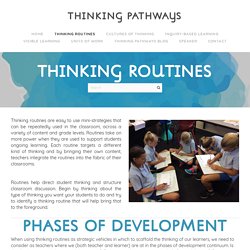
Is this the first time you have used this routine? Or have you been using it regularly for a while now? Or is it so ingrained your learners use it without realising it? The answers to these questions will depend on the routine you are using and how often it is used within your educational context. It is therefore conceivable that a learner could be at varying phases at the same time for different routines. There are a number of routines that have been grouped into a range of broad areas: 5. Pre-assessment Ideas - Differentiation & LR Information for SAS Teachers. “Assessment is today’s means of modifying tomorrow’s instruction.”

Carol Ann Tomlinson Pre-assessment provides valuable information about what is already known about a topic and readiness to start new instruction. Discovering prior knowledge allows the teacher to present new information at an appropriate level for the students. This process should continue throughout the learning process, so lessons can be adjusted according to student need. 35 Useful Remote Learning Resources - Lucky Little Learners. More and more teachers are searching for remote learning resources due to the outbreak of COVID-19.
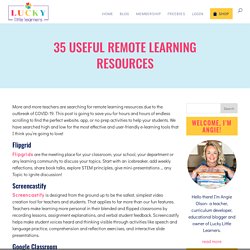
This post is going to save you for hours and hours of endless scrolling to find the perfect website, app, or no prep activities to help your students. We have searched high and low for the most effective and user-friendly e-learning tools that I think you’re going to love! Flipgrid Flipgrids are the meeting place for your classroom, your school, your department or any learning community to discuss your topics. Start with an icebreaker, add weekly reflections, share book talks, explore STEM principles, give mini-presentations … any Topic to ignite discussion! Screencastify Screencastify is designed from the ground up to be the safest, simplest video creation tool for teachers and students. Classroom Layouts: Seating Arrangements for Effective Learning - Today's Classroom. (1) 13 Study Tips: The Science of Better Learning. YouTube.
Classroom Activities: How to Hold a Classroom Debate. Are you looking for classroom activities to get your students to use their critical thinking skills?
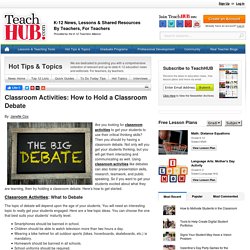
Then you should try having a classroom debate. Not only will you get your students thinking, but you will get them interacting and communicating as well. Using classroom activities like debates can also foster presentation skills, research, teamwork, and public speaking. Title. Health. (5) SOLO Taxonomy - explained using a classroom example at Pleasant Street Primary. Human body. (5) Year 9 PASS lesson. (5) Executive Function: The Brain's Control Center. Tennis for Secondary Schools. BelievePerform (@BelievePHQ) How to adapt and modify your sport activities to include all. One of the most important contributors to successful inclusion in sport activities is adapting things to suit the needs of individual participants.
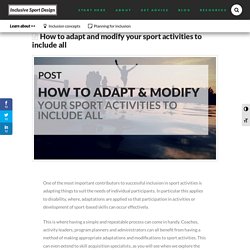
In particular this applies to disability, where, adaptations are applied so that participation in activities or development of sport-based skills can occur effectively. This is where having a simple and repeatable process can come in handy. Coaches, activity leaders, program planners and administrators can all benefit from having a method of making appropriate adaptations and modifications to sport activities. This can even extend to skill acquisition specialists, as you will see when we explore the SEMA model later. In addition to the adaptation methods we are about to explore it is important to think about the range of options that are available, for this we can apply what is called the Inclusion Spectrum. We will cover four different methods here. So lets start with the simplest and work our way towards some more advanced approaches. Rules. Memory experiments. Memory Experiments Here are some experiments and games to test your memory.
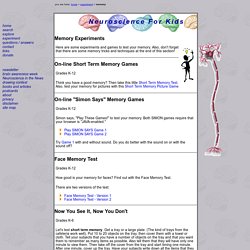
Also, don't forget that there are some memory tricks and techniques at the end of this section! On-line Short Term Memory Games Grades K-12 Think you have a good memory? On-line "Simon Says" Memory Games Simon says, "Play These Games! " Try Game 1 with and without sound. Face Memory Test. Brain Tricks - This Is How Your Brain Works. 13 Study Tips. Study Strategies: Dual Coding. 5. sexualityed fs2017acc s0v5ui. Sexualityedpolicyadvice 1nliarz. How to assess students’ prior knowledge - Eberly Center. Pre-Assessment Strategies. KWL Charts – K-what do the students already know?

W-what do the students need and want to know? L-what did the students learn? An effective pre-assessment tool and summative evaluation tool to measure the level of understanding at the end of unit. Many teachers use the L part as an open-ended question on an exam allowing the students to share the depth of knowledge that was gained in the unit of study. Yes/No Cards – Students make a card with Yes (or Got It) on one side, No (No clue) on the opposite side. SA/A/D/SD – Students are given to opportunity to formulate their own views and opinions along a continuum rather than dialectically.
Squaring Off – Place a card in each corner of the room with the following phrases: Dirt Road, Paved Road, Highway and Yellow Brick Road. Turn & Talk- During a lesson, there may be opportunities to have the students do a turn & talk activity for a few minutes. Differentiated programming. Students are individuals who learn at different rates and in different ways.
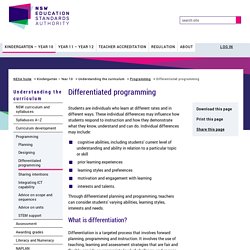
These individual differences may influence how students respond to instruction and how they demonstrate what they know, understand and can do. Individual differences may include: cognitive abilities, including students’ current level of understanding and ability in relation to a particular topic or skill prior learning experiences learning styles and preferences motivation and engagement with learning interests and talents. Through differentiated planning and programming, teachers can consider students’ varying abilities, learning styles, interests and needs. What is differentiation?
Differentiation is a targeted process that involves forward planning, programming and instruction. Master Class with John Hunter: Monday. NSW Education Standards. Information & Media Literacy Lesson. Parent-Teacher Conference Tips for Teachers. QR Code Generator - Create QR codes here. Results on ReadWriteThink. Home › Results from ReadWriteThink 1-10 of 23 Results from ReadWriteThink page | 1 2 3 Sort by: Classroom Resources | Grades K – 1 | Printout | Graphic Organizer Alphabet Chart This alphabet chart has many possibilities for helping your students learn and review their letters, sounds, phonemes, and word formations.
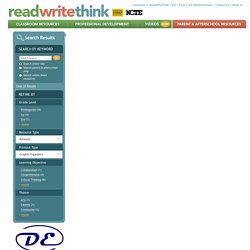
Classroom Resources | Grades K – 6 | Printout | Graphic Organizer Character Map Who are the characters in this story? Student & Teacher Planners / Diaries. Components of Fitness.